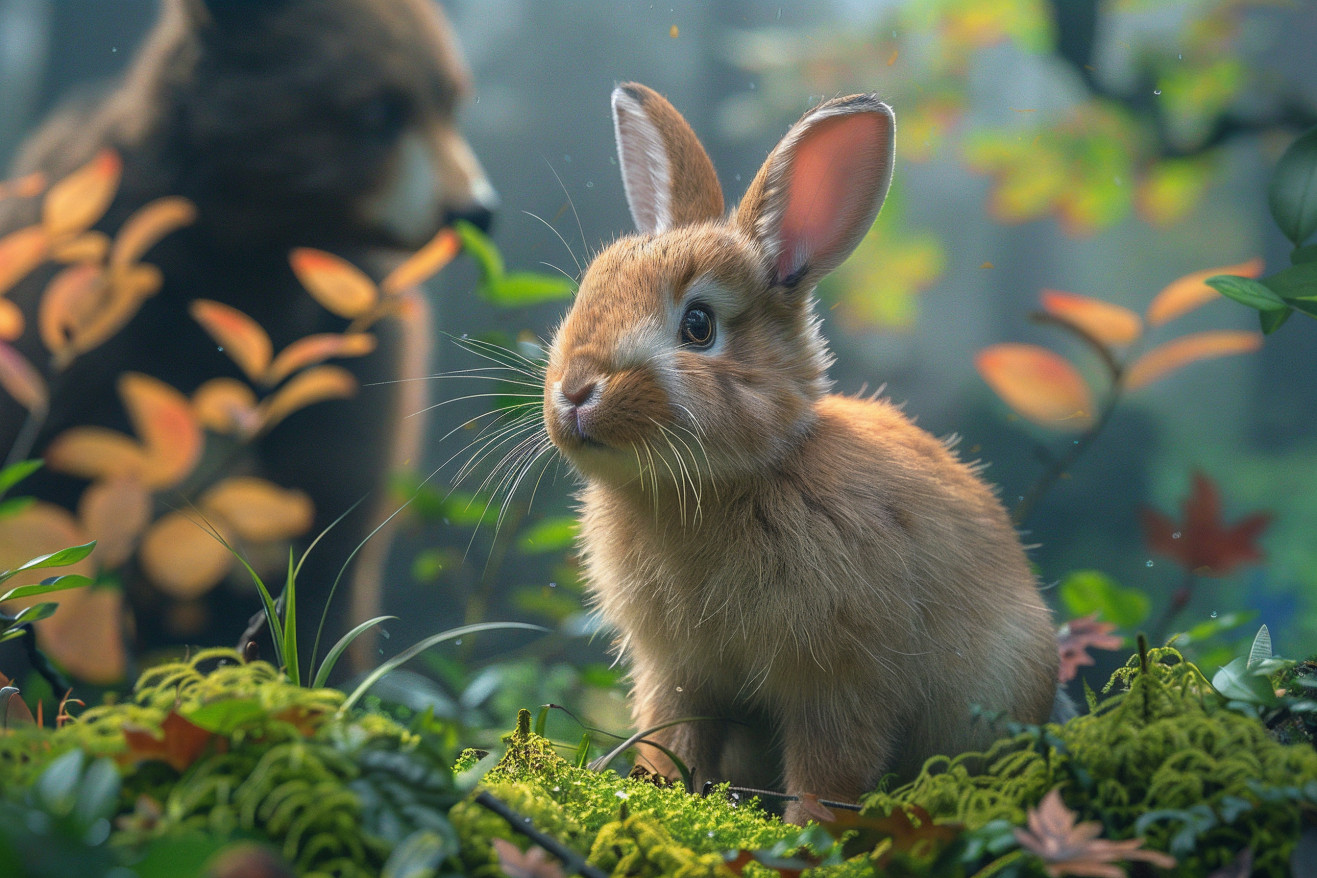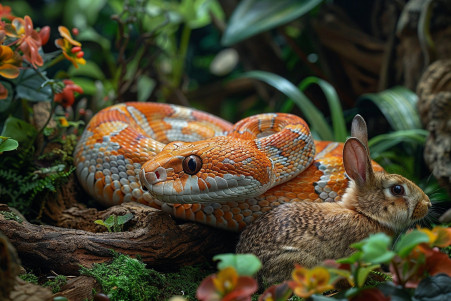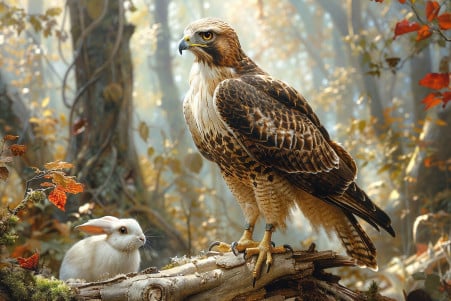When Do Bears Eat Rabbits? Insights From Wildlife Experts
13 June 2024 • Updated 13 June 2024

Are bears carnivorous and do they eat rabbits, and if so, how often do rabbits factor into their diet? While bears are omnivorous and will eat rabbits and other small mammals when the opportunity presents itself, the majority of their diet is made up of plant-based foods. Because of their small size, rabbits are not typically a bear's primary prey, but that doesn't mean that bears won't take advantage of an easy meal when they find rabbits, especially in the early spring.
We will look at the findings of wildlife biologists and bear researchers to determine exactly when and why bears eat rabbits. This will include information gathered from direct field observations, research on bear diet and scat analysis, and studies on the effects of rabbit hunting on bear and rabbit populations. This will help you understand the predator-prey relationship between these two animals and the variables that determine how likely a bear is to hunt rabbits for food.
Do bears eat rabbits?
Predator-Prey Dynamics: How Bears Hunt and Catch Rabbits
Bears are not very active predators, but they do hunt small mammals like rabbits. According to Get Bear Smart Society director Sylvia Dolson, grizzly bears hunt small mammals more frequently than black bears, as "it's not often a black bear catches a rabbit." That said, bears are opportunistic eaters and will eat rabbits when the opportunity arises, especially in the spring when they're coming out of hibernation and food is scarce.
Bears may find rabbit burrows and either wait for the rabbits to come out or frantically dig them out. As PetKeen points out, rabbits are too fast for bears to catch in the open. Instead, they rely on ambush hunting, catching rabbits in confined spaces or when they're not expecting it. While less common, there are instances of bears running down and catching rabbits, especially in urban and suburban areas where the rabbits have fewer places to run.
The predator-prey dynamics show that while rabbits aren't a major food source, they can be an opportunistic one for bears. This mammal's place in the bear diet shows the nutritional value it can provide these omnivores.
Nutritional Value: What Bears Get From Eating Rabbits
Rabbits are a good source of protein, iron, and B vitamins such as B12 and niacin, all of which are important for the growth, repair, and energy needs of bears' muscles, according to a fact sheet from the Northwest Territories Health and Social Services. The fact that rabbit meat is low in fat and cholesterol means that the nutrients it does contain are high-quality and not diluted, which is especially important for bears who need to refuel after hibernation.
That said, the Alaska Department of Fish and Game cautions that rabbits can also carry parasites or diseases that could be harmful to bears, so care should be taken to ensure that the rabbits are safe to eat. As The Washington Post notes, bears eat a diet that's about 80% vegetarian, including a wide range of leafy greens, berries, and other wild plants. This shows that while rabbits aren't a major part of bears' diets, they can still be important for providing bears with the nutrients they need, especially at certain times of the year.
Coexistence and Competition: Bears and Rabbits in Shared Habitats
Bears and rabbits are two species that often live in the same natural habitats, which means they also share the same resources and space. According to the California Department of Fish and Wildlife, the increasing number of human-wildlife interactions reported across the state highlights the need to safeguard and enhance the coexistence of these species.
Although bears may hunt rabbits from time to time, this isn’t a major factor in their interactions or population dynamics. As the Oklahoma Department of Wildlife Conservation points out, cottontail rabbits are a primary food source for many predators, but their ability to jump and change direction quickly makes them a difficult target for predators.
Competition for food, especially when it’s scarce, is more likely to lead to interactions between the two species. The Utah Division of Wildlife Resources explains that rabbits live in burrows below ground, while hares live above ground. This difference in habitats can lead to competition for resources in the same area.
Human activities, such as habitat destruction and the introduction of invasive species, can also upset the balance between bears and rabbits. It’s important to work to mitigate these impacts to ensure that these species can continue to coexist in the same environments.
Conflict Mitigation: How to Help Bears and Rabbits
Effective management and conservation are important for the well-being of both bear and rabbit populations, says the CDFW Human-Wildlife Conflict Program. One way to prevent conflicts is to inform the public about the best ways to behave in bear territory, including how to store food and how to avoid interactions. As the Vernon Morning Star explained, bears can be attracted to small animals like rabbits if they are easy to catch, so public education is important.
Another way to help is to protect habitats and create wildlife corridors that allow bears and rabbits to move around and live together, especially since the Oklahoma Department of Wildlife Conservation says that cottontail rabbits are a critical food source for many predators. Finally, it's important to monitor and mitigate the effects of human activities, including development and pollution, on the ecosystems that both bears and rabbits rely on.
These are all practical steps that can be taken to help reduce conflicts and protect the relationship between bears and rabbits in their overlapping environments.
Conclusion: What This Relationship Means
Bears and rabbits are two of the many species that live in the same ecosystems and share the same resources. According to the California Department of Fish and Wildlife, the growing number of human-wildlife interactions being reported throughout the state emphasizes the importance of protecting and promoting the coexistence of these animals.
Although bears are known to eat rabbits from time to time, the predator-prey relationship between the two species is not a major factor in their interactions or population impacts. According to the Oklahoma Department of Wildlife Conservation, cottontail rabbits are an important food source for predators, but they are also able to escape predators by leaping and dodging.
One of the main factors that can lead to increased interactions between bears and rabbits is competition for food, especially when resources are scarce. According to the Utah Division of Wildlife Resources, rabbits and hares have different ecological niches, with rabbits living in underground burrows and hares living above ground. However, the two species often live in the same areas, which can lead to competition for food.
Human impacts, including habitat destruction and the introduction of invasive species, can also disrupt the relationship between bears and rabbits. It's important to minimize these impacts in order to ensure that bears and rabbits can continue to coexist in the wild.


